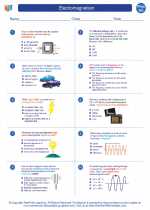Hybridization in Chemistry
Hybridization in chemistry is a concept that describes the mixing of atomic orbitals to form new hybrid orbitals. This process occurs when atoms form covalent bonds and is essential in understanding the shapes and bonding properties of molecules.
Key concepts:
- Atomic Orbitals: These are regions in space where an electron is likely to be found around the nucleus of an atom.
- Hybrid Orbitals: These are formed by mixing atomic orbitals and are used by atoms to form covalent bonds with other atoms.
- Hybridization Types: The most common types of hybridization are sp, sp2, and sp3, which involve the mixing of s and p orbitals in different ratios.
- Geometry and Bond Angles: The hybridization of an atom influences the molecular geometry and bond angles in a molecule.
Study Guide:
To understand hybridization, it's important to grasp the following key points:
- Atomic Orbitals: Review the concept of atomic orbitals and their shapes (s, p, d, etc.)
- Hybridization Types: Learn about the different types of hybridization (sp, sp2, sp3) and the corresponding hybrid orbitals formed.
- Molecular Geometry: Understand how hybridization influences the shape of molecules and the bond angles.
- Examples and Practice: Work through examples of molecules and determine their hybridization and geometry.
Example:
Let's consider the molecule methane (CH4). The carbon atom in methane undergoes sp3 hybridization, forming four sp3 hybrid orbitals, which arrange themselves in a tetrahedral geometry with bond angles of approximately 109.5 degrees.
Conclusion:
Hybridization is a fundamental concept in chemistry that provides insights into the structure and properties of molecules. Mastering this topic is crucial for understanding chemical bonding and molecular shapes.
[Hybridization] Related Worksheets and Study Guides:
.◂Physics Worksheets and Study Guides High School. Electromagnetism

 Worksheet/Answer key
Worksheet/Answer key
 Worksheet/Answer key
Worksheet/Answer key
